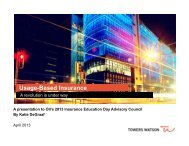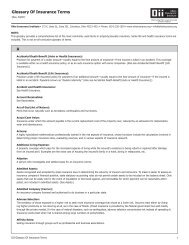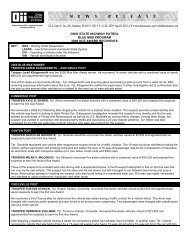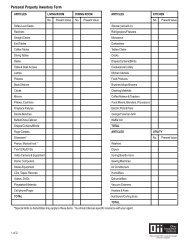Untitled - Ohio Insurance Institute
Untitled - Ohio Insurance Institute
Untitled - Ohio Insurance Institute
Create successful ePaper yourself
Turn your PDF publications into a flip-book with our unique Google optimized e-Paper software.
• IN MALLS OR LARGE BUILDINGS<br />
Many large public buildings will have designated shelter areas.<br />
Become familiar with signs posted in these buildings. If you can’t<br />
locate the designated area, go to a middle hallway on the lowest<br />
level.<br />
• IF OUTSIDE<br />
If you can’t reach a shelter or building, lie flat in a ditch or low area,<br />
covering your head and the back of your neck with your hands.<br />
Stay clear of tall trees and open water.<br />
l POINTS TO COVER<br />
• The proper position to assume for protection<br />
• Where to go when a tornado strikes at home, outside, in a car, school<br />
or other building<br />
• Emergency preparedness plans<br />
l ACTIVITIES<br />
1. Have students act out a home tornado drill skit. Action may be different<br />
depending on type of residence (home with/without basement,<br />
apartment, mobile/manufactured home, etc.).<br />
2. Make sure all students participate in a tornado drill.<br />
3. Have students practice the proper position to assume during a tornado<br />
at school.<br />
4. Have students write a report that outlines where they would go if a<br />
tornado warning was issued while home.<br />
5. Have students develop a basic home emergency preparedness plan.<br />
Suggest they share the plans during a family meeting (www.weather<br />
safety.ohio.gov/disasterplan.aspx).<br />
watch for<br />
lightning<br />
When a tornado strikes, severe lightning will often be present. Many<br />
times the threat lightning poses is overlooked. According to the National<br />
Weather Service, over the past 30 years lightning caused about<br />
67 deaths and 300 injuries in the US each year—more than the average<br />
number of deaths attributed to tornadoes or hurricanes.<br />
l LIGHTNING FACTS<br />
• The frequency of lightning strikes varies by region. In the northwest<br />
area of the US, there are areas with fewer than five thunderstorms a<br />
year, while areas of central Florida experience close to 90. <strong>Ohio</strong> averages<br />
between 30–50 thunderstorm days a year.<br />
• Structures located on high terrain, such as mountain ranges, or buildings<br />
that are substantially higher than those adjacent to them are<br />
at a higher risk of lightning strikes. Structures adjacent to water also<br />
have a higher susceptibility rate, since water serves as a conductor.<br />
• A typical thunderstorm is 15 miles in diameter and lasts an average of<br />
30 minutes. Nearly 1,800 occur at any moment around the world—<br />
that’s 16 million a year!<br />
• Of the estimated 100,000 that occur in the US annually, about 10%<br />
are classified as severe. The National Weather Service considers a<br />
thunderstorm severe if it produces hail at least 3/4 inch in diameter<br />
and/or includes damaging winds clocked at 58 mph or higher.<br />
• According to the Lightning Protection <strong>Institute</strong>, roofs and projections,<br />
such as chimneys and steeples are most frequently hit by<br />
lightning strikes.<br />
l WHAT CAUSES LIGHTNING?<br />
The action of rising and descending air within a thunderstorm separates<br />
positive and negative charges. Lightning results from the buildup<br />
and discharge of electrical energy between positively and negatively<br />
charged areas.<br />
l OTHER ONLINE LIGHTNING RESOURCES<br />
• www.lightningsafety.noaa.gov<br />
Check the NOAA Lightning Safety Team site for handouts, indoor<br />
and outdoor safety tips, medical facts, history, survivor stories,<br />
photos, teacher tools and more. Lightning Safety Awareness Week<br />
is June 24–30, 2007. Additional NOAA site info on lightning is available<br />
at www.noaa.gov/lightning.html.<br />
• www.lightning.org<br />
The Lightning Protection <strong>Institute</strong> (LPI) presents information designed<br />
to provide a basic understanding of lightning, the severity<br />
of lightning strikes and lightning protection systems.<br />
• www.usatoday.com/weather/resources/basics/wlightning.htm<br />
Visit the Lightning Science and Safety section of the USA Today site<br />
for info on lightning basics, different forms of lightning, lightning<br />
rods, research and much more.<br />
• www.science.howstuffworks.com/lightning.htm<br />
This site explains how lightning works along with links to related<br />
info.<br />
l LIGHTNING SAFETY TIPS<br />
1. Outdoor Tips<br />
• Avoid water, especially swimming pools, and metal objects such<br />
as electrical wires, fences, golf clubs, machinery, power tools and<br />
railroad tracks.<br />
• Unsafe places during lightning include tents, golf carts, small<br />
open-sided shelters and under isolated trees.<br />
• Avoid wide open spaces and high terrain such as hilltops.<br />
• When possible, get to a building or fully enclosed shelter like a car<br />
or truck and close the windows.<br />
• If lightning strikes are nearby, avoid direct contact with others;<br />
remove metal objects from your pockets and crouch low to the<br />
ground on the balls of your feet, place hands on your knees with<br />
your head between them.<br />
• If you’re in the woods, take shelter under the lowest tree or under<br />
a bush.<br />
2. Indoor Tips<br />
• Avoid contact with water including showers, baths or laundry. Stay<br />
away from open doors and windows.<br />
• Don’t use corded or cordless phones or headsets during lightning<br />
storms because a strike could send shocks through the electric or<br />
phone line. A cell phone is the safest mode of communication during<br />
thunderstorms.<br />
• As an extra precaution unplug computers, stereos, power tools,<br />
TVs and DVDs, and other unnecessary appliances.<br />
• Stay inside until the storm subsides.<br />
3. First Aid for Lightning Victims<br />
• Call 911 immediately.<br />
• A person struck by lightning may be burned, but does not carry an<br />
electrical charge. So begin first aid procedures immediately.<br />
• If the victim is not breathing but has a pulse, administer mouth-tomouth<br />
resuscitation. If there’s no pulse, begin CPR.<br />
l POINTS TO COVER<br />
• Where to go in case of lightning<br />
• What to avoid in case of lightning<br />
• Types of materials that attract lightning<br />
• General lightning safety tips (available at www.weathersafety.ohio.<br />
gov/thunderstormslightning.aspx)<br />
4









